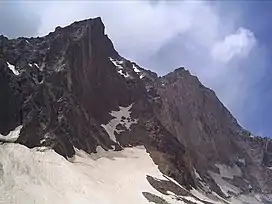Alam-Kuh
Alam-Kūh (Persian: علمکوه; also: Alam Kooh) – Mount Alam – is a mountain in Alborz mountain range in northern Iran, Mazandaran Province, forming a peak of Takht-e Suleyman Massif. It is located in Kelardasht District of Mazandaran Province of Iran. With an elevation of 4,828 meters, it is the second-highest peak in Iran after Mount Damavand.[2]
| ʿAlam-Kūh | |
|---|---|
| Kuhha-ye Alborz | |
 | |
| Highest point | |
| Elevation | 4,850 m (15,910 ft)[1] |
| Prominence | 1,827 m (5,994 ft)[1] |
| Listing | Ultra |
| Coordinates | 36°22′32.65″N 50°57′41.31″E[1] |
| Geography | |
 ʿAlam-Kūh Iran | |
| Location | Mazandaran, Iran |
| Parent range | Alborz |
| Climbing | |
| First ascent | 1902 by Alfred and Joseph Bornmüller |
| Easiest route | rock, snow, ice |
Climbing history

The first recorded ascent of the peak was made from Hazarchal over the south face by the German brothers Bornmüller during their six-month botanical exploration of the Alborz in 1902.[3][4]
Douglas Busk, a British mountaineer, climbed Alam-Kuh via the east ridge in 1933 and again in 1934 from over the west ridge.[5]
The 800 m high, steep granite north face provides some of the most difficult and interesting mountaineering routes in the country and the climbs rank alongside major climbing routes in the European Alps. In addition to local climbers, the north face attracts European climbing teams. The first known ascent from the north was by a German party (Gorter/Steinauer) in 1936 via the northwest ridge.[6] Subsequently, French and Polish teams established other routes on the north face during the 1960s and 1970, these being multi-day routes of high alpine standard. A British team followed with a successful ascent in 1978. The first winter ascent of the north face was made by Mohammad Nouri in 1991.
2004 earthquake
Most of the fixed ropes were damaged severely during a major 6.3 magnitude earthquake[7] and consequent rockfall in 2004. The mountain was closed to climbers for some months because of the hazard of rockfall and loose cables.
Terrain and approach
The mountain range supports permanent snow and glaciers. Although the southern slopes of the range tend to be dry and barren, the northern valleys leading to the Caspian Sea (which offer the best approaches to the mountains) are wet and lush with vegetation.
Location
| Map of central Alborz | Peaks: | 1 Alam-Kuh |
|---|---|---|
 −25 to 500 m (−82 to 1,640 ft) 500 to 1,500 m (1,600 to 4,900 ft) 1,500 to 2,500 m (4,900 to 8,200 ft) 2,500 to 3,500 m (8,200 to 11,500 ft) 3,500 to 4,500 m (11,500 to 14,800 ft) 4,500 to 5,610 m (14,760 to 18,410 ft) |
2 Azad Kuh | 3 Damavand |
| 4 Do Berar | 5 Do Khaharan | |
| 6 Ghal'eh Gardan | 7 Gorg | |
| 8 Kholeno | 9 Mehr Chal | |
| 10 Mishineh Marg | 11 Naz | |
| 12 Shah Alborz | 13 Sialan | |
| 14 Tochal | 15 Varavašt | |
| Rivers: | 0 | |
| 1 Alamut | 2 Chalus | |
| 3 Do Hezar | 4 Haraz | |
| 5 Jajrood | 6 Karaj | |
| 7 Kojoor | 8 Lar | |
| 9 Noor | 10 Sardab | |
| 11 Seh Hazar | 12 Shahrood | |
| Cities: | 1 Amol | |
| 2 Chalus | 3 Karaj | |
| Other: | D Dizin | |
| E Emamzadeh Hashem | K Kandovan Tunnel | |
| * Latyan Dam | ** Lar Dam |
See also
References
- "Iran: 54 Mountain Summits with Prominence of 1,500 meters or greater" Listed here as "Kuhha-ye Alborz". Peaklist.org. Retrieved 2012-02-25.
- Sources differ on the height of Alam Kuh. Due to its elevation being very close to that of Sabalan, either of these peaks may be variously listed as either the second or third highest mountain in Iran. Some sources give a significantly higher elevation for Alam Kuh of 4850 m. However, more reliable sources such as Peaklist (Alam Kuh has listed here as "Kuhha-ye Alborz") state an elevation of 4805 m based on Soviet topographic maps and modern SRTM data. This data supports Alam Kuh as the second highest peak in Iran.
- J. Bornmüller, Beiträge zur Flora der Elbursgebirge Nord-Persiens, 1908
- J.G.R. Harding, Cambridge Expedition, 1956, to the Elburz Mountains, Iran, The Himalayan Journal, Vol 20
- D.L. Busk, Climbing in the Takht-i-Suleiman Group, N. Persia: The Alpine Journal, v. 47, p. 299–309 (1935).
- D.L. Busk, The German expedition in the Elburz Range, N. Persia: The Alpine Journal, v. 49, p. 245-247 (1937).
- "Deadly earthquake rocks Iran" Archived 2012-09-24 at the Wayback Machine CNN.com. Retrieved 2012-02-25.
External links
- "Alam Kuh, Iran" on Peakbagger
- SummitPost website
- "Alam-Kuh". Peakware.com. Archived from the original on 2016-03-04.
- "Iran: Alam Kuh" in The American Alpine Journal, 2002